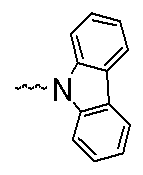
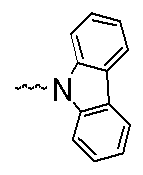
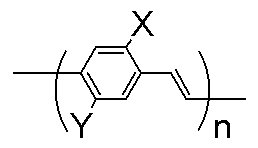
OL1 OL2 1 2 3 4 5 6 7 8 9 10 PDL
HIROO INOKUCHI
Space Utilization Research Programme
National Space Development Agency of Japan
2-1-1, Sengen Tsukuba, Ibaraki 305-8505 Japan
More than 50 years have past since the discovery of electrical conduction in some organic solids, which had been classified as typical electrical insulators. The studies in this field have developed in three ways: (1) The measurement of electrical conductivity in phthalocyanine, a compound analogous to heme, a biological substance. The work was inspired by energy transfer in biological systems. (2) The measurement of electrical conduction in cyanine dyestuffs in order to elucidate the mechanism of energy transfer in photosensitizing materials. (3) Our discovery of electrical conduction in aromatic organic solids. The breakthrough issued from the consideration of the characteristics that both polycyclic aromatic compounds and highly electrically-conductive graphite possess many π-electrons in the compounds. The studies of these single-component organic conductors led to the recent discovery of new conductors, owing to persistent investigations on sulfur-containing aromatic compounds and related ones.
The studies of two-component organic conductors, starting from that of perylene-halogen complexes in 1954, have also advanced for 50 years. Electron donors and acceptors, such as TCNQ, TTF, BEDT-TTF, etc, were newly synthesized, which modified organic semiconductors to organic metals, and further led to the generation of organic superconductors. This field of material science has developed under cooperation of chemists and physicists to produce remarkable results.
The origin of three-component organic conductors is found in graphite intercalation compounds, i.e., graphite-alkali metal-hydrogen ternary systems. Various organic conductors are expected to appear for three-component organic solids containing hydrogen, since arrayed hydrogen in solids contributes to electrical conductivity.
SCIENTIFIC REVIEW ON ORGANIC FIELD EFFECT TRANSISTORS
N. Karl
3. Physikalisches Institut, University of Stuttgart, D-70550 Stuttgart, Germany
e-mail: n.karl@physik.uni-stuttgart.de
Organic field effect transistors use wide bandgap molecular semiconductor materials – instead of silicon or gallium arsenide – to switch electric currents in electronic devices. Organic molecular materials are not only promising for economic reasons, but also offer the possibility of tuning their electronic properties by ”chemical tailoring”, i.e. by modifying molecular backbone structures and by varying substituents. Furthermore there is the prospect that ultimately very few, or even single molecules can be used to transmit, handle, or store information data on the smallest possible scale and, therefore, with the highest possible packing density.
A review will be given on the evolution of ideas, the experimental exploration, the development of basic physical understanding, and the realization of technical prototype devices.
Some details are especially worth mentioning: It had been shown long ago that, despite the weakness of the intermolecular interactions, unexpectedly high charge carrier mobilities can be achieved in structurally well-ordered and chemically pure molecular solids at low temperature. According to recent reports experimental charge carrier mobility values could be extended up to 105 cm2/Vs, which – in conjunction with large injected space charge densities in field effect transistor geometry – led to the observation of integer and fractional quantum Hall effect plateaus, reflecting the quotient of the fundamental constants h/e2 (a natural resistivity standard), and to the discovery of single component organic superconductivity with comparatively high transition temperatures. It is fascinating that in these devices, for the first time, switching from an electrical insulator to a superconductor state became possible by mere application of a gate voltage, causing quasi two-dimensional “injection doping” of the insulating organic layer.
The aspects mentioned above have recently led worldwide to a huge increase of academic as well as industrial research and development activities focussing on organic semiconductor materials and devices.
POLARIZATION ENERGIES, TRANSPORT GAP AND CHARGE TRANSFER STATES OF ORGANIC MOLECULAR CRYSTALS
Z.G. SOOS, E.V. TSIPER
Department of Chemistry, Princeton University, Princeton NJ 08544 USA. Soos@Princeton.edu
Crystalline thin films of conjugated organic molecules are the basis for a variety of organic devices that involve charge transport as well as electronic excitation. Transport states for electrons and holes correspond to the crystal’s electron affinity and ionisation potential, respectively, and differ by 1–2 eV from gas-phase values due to polarisation. We present a practical new way to compute electronic polarisation without using submolecules. By neglecting intermolecular overlap, we reduce the polarisation problem to classical electrostatic interactions in a lattice of quantum molecules and obtain self-consistent atomic charges, induced dipoles, Coulomb potentials and electric fields in large, mesoscopic systems of thousands of molecules. With the aid of an atom-atom polarizability tensor, we find that purely molecular inputs and the crystal structure yield the indices of refraction of the crystal, the polarisation energies of anions and cations, and the energies of ion pairs or charge-transfer states at fixed separation. The self-consistent procedure is applicable to idealised surfaces and inert interfaces of thin films on metallic substrates. Results are presented for anthracene, pentacene and PTCDA (perylenetetracarboxylic dianhydride) crystals, and for PTCDA films. The polarisation energy of a PTCDA monolayer is 500 meV greater than in 50 Å films, in excellent agreement with photoelectron and tunnelling electron spectra on gold or silver. Electronic polarisation has a major role in transport states that describe charge injection and charge transport in molecular solids with limited intermolecular overlap.
EXCITON DISSOCIATION IN CONJUGATED POLYMERS
V. I. Arkhipov (1), H. Bässler (1), E. V. Emelianova (2), D. Hertel (1, 3), V. Gulbinas (4), C. Im (1) and L. Rothberg (3)
(1) Institute of Physical Chemistry, Philipps-University, Postbox, D-35032 Marburg, Germany
(2) Laboratorium voor Halfgeleiderfysica, Univerity of Leuven, Celestijnenlaan 200D, B-3001 Heverlee-Leuven, Belgium
(3) Chemistry Department, University of Rochester, Rochester, NY 14627, U. S. A.
(4) Institute of Physics, A. Gostauto 12, Vilnius, Lithuania
Meanwhile there is conclusive evidence that in conjugated polymers the dominant optical excitation is an singlet exciton with a binding energy of about 0.5 eV. Optical generation of charge carrier is, therefore, an endothermic process. Based upon (i) fluorescence quenching by an electric field, (ii) delayed field collection of photogenerated charge carriers and (iii) transient photo-induced absorption it will be shown that vibrationally relaxed singlet excitons can dissociate into geminate electron hole pairs provided that a strong electric field is applied. This is at variance with the classic Onsager formalism to rationalize photogeneration which rests on the notion that the primary dissociation step is independent of electric field and temperature. In conjugated polymers the situation reverse, i.e. the bottle neck is field assisted formation of a geminate e-h pair. Analytic theory can provide a quantitative understanding of the process.
STEERING MOLECULES BY LIGHT:
FROM NLO AS A GOAL TO NLO AS A TOOL
Joseph ZYSS
Laboratoire de Photonique Quantique et Moléculaire (CNRS UMR 8537)
Institut d'Alembert, Ecole Normale Superieure de Cachan
61 avenue du Président Wilson 94235 Cachan Cedex, France
Light induced "tensorial" patterning of organic materials opens-up a wide range of perspectives towards polarization-independent non-linear quadratic materials [1,2], microcavities, high density tensorial optical storage, quasi phase matched and photonic crystal patterns. The underlying mechanism is based on resonant illumination of a photosensitive non-linear medium, such as a dye doped polymer film, by a strong incoming Ew fundamental field interfering with a weaker E2w harmonic field. A non-centrosymmetric angular equilibrium distribution is reached by cycling of joint one- and two-photon absorption processes intertwined with mechanical relaxation pathways such as photoisomerization. The resulting all-optical poling scheme enables to engineer the symmetry of photoinduced non-linear tensors by control of the writing field polarizations which can be adjusted to its molecular tensorial symmetry counterpart [2,3]. The concept of multipolar tensorial symmetry is shown to be equally valid for molecular susceptibilities [3] and the tensor product of the encoding polarization states with matching irreducible orders leading to clear-cut symmetry based selection rules. This light-driven process applies also to fluorescent chromophores imbedded in a polymer matrix which may then present a conjunction of nonlinear and luminescence properties. Simultaneous measurement of second harmonic generation (SHG) and one- and two-photon fluorescence (OPF and TPF) anisotropies permit to access the orientational distribution of molecules up to the fourth order moment. Such structures open-up new directions towards multifunctional polymers for self-frequency doubling organic lasers or more generally micro- and nano-structured luminescent materials with possible applications in nonlinear photonics and bio-photonics.
[1] "Molecular Photonics: Material, Physics and Devices" (C.R. Acad. Sciences) special issue (J.Zyss Edit.), vol.4 (May 2002) (Elsevier)
[2] ”Multipolar molecules and multipolar fields: probing and controlling the tensorial nature of molecular non-linear media”, S.Brasselet and J. Zyss, J. Opt. Soc. Am. B 15(1), 257 (1998)
[3] "Molecular engineering implications of rotational invariance in quadratic nonlinear optics", J.Zyss, J.Chem.Phys. 98,297(1994)
CHARGE CARRIER GENERATION AND TRANSPORT IN PHOTOREFRACTIVE APPLICATIONS
D. HAARER, R. BAUSINGER AND A. LEOPOLD
University of Bayreuth, Experimentalphysik IV, 95440 Bayreuth, Germany
The rates of charge carrier production, charge carrier transport and charge carrier trapping determine the time constants of the buildup of the space charge field in photorefractive materials. For a series of photorefractive glasses time of flight experiments and holographic time of flight experiments show that there is a delicate interplay between fast transport and efficient trapping of charge carriers.
We also investigated the orientational enhancement effect of photorefractive polymers and show with experiments in the vicinity of the glass transition temperature that the orientational Kerr-component can, at temperatures close to or above Tg, compete with the speed of the electronic Pockels-component.
In the outlook we will briefly discuss how these opto-electronic features of organic systems are also pertinent to other applications such as, for instance, photovoltaic applications.
RECOMBINATION RADIATION FROM ORGANIC SOLIDS*
J. KALINOWSKI
Department of Molecular Physics, Technical University of Gdańsk,
ul. G. Narutowicza 11/12, 80-952 Gdańsk, Poland
The oppositely charged carriers (e.g. holes and electrons) recombining in an organic solid release a considerable amount of energy which can be emitted in the form of electromagnetic radiation. This is called recombination radiation. Its intensity and spectral range depend on the population and nature of the emitting states which differ, in general, from those created with light. In this paper, these differences will be discussed, pointing out the opposite pathways of the mutual transformation of localized and separated charge-pair excited states formed either by photoexcitation or electron-hole recombination. While under photoexcitation the primary excited states are, as a rule, localized molecular excitons, coulombically-correlated charge pairs are formed prior to molecular localization of charges in the recombination of statistically independent charge carriers. Two molecule – excited states like excimers or electromers occur often with relatively high efficiencies in single-component molecular solids, and exciplexes or electroplexes in multi-component samples, as a result of the charge recombination process. Their radiative decay leads to characteristic emission bands positioned in the long-wavelength regions of the emission spectra, and moving within them with applied electric field when oppositely charged carriers are injected from electrodes in systems like organic light emitting diodes (LEDs). A number of examples of the emission spectra of organic LEDs will be presented and compared with the fluorescence and phosphorescence spectra of the materials used for their fabrication. The effect of electric field on the quantum efficiency of the emission from organic solids will be briefly described and its role for performance of organic LEDs pointed out. The basic physical processes that need to be considered when analyzing quenching of the emission are: exciton-exciton and exciton-charge carrier interactions, and electric-field-enhanced dissociation of emitting excited states and/or their precursors. An outline of underlying problems will be given in the context of the difference and variety of excited states produced under different excitation conditions in single- and bi-layer organic material structures.
--------------------------------
* The work supported in part by the Research Grant of the US Navy, Office of Naval
Research (ONR).
Conjugated Polymer Based ONSolar Cells
Niyazi Serdar Sariciftci
Linzer Institut für organische Solarzellen (LIOS), Physikalische Chemie,
Johannes Kepler Universität Linz
Altenbergerstr. 69, A-4040 Linz, Austria
Recent developments on conjugated polymer based photovoltaic elements are reviewed. The photophysics of such photoactive devices is based on the photoinduced charge transfer from donor type semiconducting conjugated polymers onto acceptor type conjugated polymers or acceptor molecules such as Buckminsterfullerene, C60. This photoinduced charge transfer is reversible, ultrafast (within 40 femtoseconds) with a quantum efficiency approaching unity, and the charge separated state is metastable (up to milliseconds at 80K). Similar to the first steps in natural photosynthesis, this photoinduced electron transfer leads to a number of potentially interesting applications which include sensitization of the photoconductivity and photovoltaic phenomena. Examples of photovoltaic architectures are discussed with their potential in terrestrial solar energy conversion. Recent progress in the realization of improved photovoltaic elements with >3% power conversion efficiency is reported.
NONLINEAR CHIRO-OPTICAL ACTIVITY IN CHIRAL ORGANIC MOLECULAR COMPLEXES AND POLYMERS
C. FLYTZANIS
Laboratoire de Physique de la Matiere Condensee, Ecole Normale Superieure, 24 rue Lhomond, 75231 Paris, Cedex 05, France
Molecular chirality is an important issue in stereochemistry with crucial implications in crystal growth, asymmetric catalysis and molecular recognition . Optical activity or circular power and dichroism are conspicuous features of molecular chirality and along with other stereochemical techniques play a key role in providing structure information regarding chiral molecular complexes and polymers.
Certain nonlinear optical effects also bear distinct signature of the molecular chirality and the determination of the corresponding nonlinear chiro-optical susceptibilities can be used to probe and assess structural and dynamical features of the molecular chirality. In certain cases they may even provide photoinduced chiro-optical functionality.
In the light of recent interesting experimental studies we summarize and review the chirality specific features in the quadratic and cubic optical nonlinearities and discuss how their determination can provide important information regarding either the electronic charge distribution and wave function configuration or the molecular orientation of chiral molecular complexes in relation to their environment in solutions or interfaces. We also assess the underlying mechanisms for the chiro-optical activity, linear and nonlinear, of chiral molecules and polymers and compare chiro-optical effects with the magneto-optical ones and their specific manifestation in some simple cases of nonlinear optical propagation.
Circular Dichroism, Principles and Applications, N. Berova, K. Nakanishi, R.W. Woody (eds), Wiley-VCH 2000.
J.A. Giordmaine, Phys. Rev. 138, A1599 (1965)
N.I. Koroteev, Frontiers in Nonlinear Optics. The Sergei Akhmanov memorial volume, H. Walther, N.I. Koroteev , M.O. Scully(eds), IOP Bristol 1993.
J.D. Byers, H.I. Yee, T. Petralli-Mallow, J.M. Hicks, Phys. Rev. B 49, 14643 (1994).
H. Ashitaka et al, Nonlinear Opt. 4, 281 (1993)
M.A. Belkin, S-H Hau, X. Wei, Y.R. Shen, PRL 87, #11300 (2001) and to be publ.
B. Busson, M.Kauranen, C. Nuckolls, T.J. Katz, A. Perssons, PRL 84, 79 (2000)
H. Mesnil et al, Chem. Phys. Lett. 338, 269 ( 2001).
C. Tziligakis et al, Nonlinear Opt. 13, 215 (1995)
OPTICAL STRUCTURING OF PLASTIC MATERIALS FOR ELECTRONICS
Jean-Michel NUNZI1, Aleksandra APOSTOLUK1, Laurent GUERIN1,
Céline FIORINI-DEBUISSCHERT2, Christophe HUBERT2,Gilles LEMERCIER3, Chantal ANDRAUD3.
1 Université d’Angers, Laboratoire POMA, 2 Boulevard Lavoisier, 49045 Angers, France
2 Laboratoire Composants Organiques, DRT-LIST-DECS-SE2M, CEA Saclay, 91191 Gif sur Yvette, France
3 Stéréochimie et Interactions Moléculaires, Ecole Normale Supérieure de Lyon, 46 allée d’Italie, 69364 Lyon, France
We review some principles of optical structuring of organics materials for photonic and electronic device applications. Azo-dye aromatic polymers have been shown to offer interesting perspectives in this respect. Controlling the rich possibilities of light - matter interactions permits to achieve a complete manipulation of the molecular order and concentration in plastic materials.
Several well-known and new effects are discussed:
As an application, some results on optically pumped Distributed Feed-Back organic lasers and Quasi Phase-Matched frequency conversion devices are presented. Applications can also be found in the improvement of organic diodes.
M. IWAMOTO
Department of Physical Electronics, Tokyo Institute of Technology, 2-12-1 O-okayama, Meguro-ku, Tokyo 152-8552, Japan
Many organic materials that are interesting in terms of electronics have been synthesized and discovered during the past few decades. Among them is the successful preparation of ultrathin polymer films such as polyimide Langmuir-Blodgett Films with a monolayer thickness of 0.4 nm. Using the Surface Potential method, the interfacial electrostatic phenomena have been examined, and the spatial charge distribution and electronic density of states have been determined. The presence of excess negative charges at the nanometric metal-film interface, which depend on the work function of metal electrodes, has been revealed, due to the alignment of the surface Fermi-level of polymer films and Fermi level of metals. It was found that the electrical conduction is ruled by the interfacial phenomena, that is, the I-V and C-V characteristics of metal-polyimide-metal junctions were well explained taking into account the nanometric interfacial space charge. Similarly, the step structure observed in the I-V characteristics of metal-polyimide-rohodamine-polyimide-metal junction was well explained taking into account the nanometric space charge. Further it was found that the electrical breakdown mechanism of nano-meter thick polyimide film under a needle-plane electrode system is quite different from that of maicro-meter thick films, owing to the presence of interfacial nano-metric space charge. That is, the electrical breakdown voltage is strongly dependent on the amount of space charge in polyimide films deposited on metals, and not on the kinds of needle electrode. As mentioned above, the electrical property of ultra-thin polyimide film is quite different from that of thick films. For a better understanding of the electric property of ultrathin films, it is instructive to know the relationship between the function and structure of monolayer polymer film, because the monolayer provides the most general system due to the syrnmetry breaking at the interface. Using the Maxwell displacement current (MDC) measurement coupled with SHG measurement is very effective to explore the dielectric property of monolayer films. Some monolayer ňlm has been examined using this method and the orientational order has been determined.
1) M.Iwamoto and C.X.Wu, The Physical Properties of Organic Monolayers, WorldScientic, Singapore, 2000.
LUMINESCENCE PROPERTIES OF NOVEL PPV DERIVATIVES AND LOW MOLAR MASS MOLECULES BEARING CARBAZOLE AND OXADIAZOLE MOIETIES
SOON-WOOK CHA, KYUNGKON KIM, AND JUNG-IL JIN
Division of Chemistry and Molecular Engineering and Center for Electro- and Photo-Responsive Molecules, Korea University, Seoul 136-701, Korea
Photo- (PL) and electroluminescence (EL) properties of a series of novel derivatives of poly(p-phenylenevinylene) (PPV) have been studied], and they were compared with those of PPV.



 P-1 : X = H Y
= P-2 : X = Y =
P-1 : X = H Y
= P-2 : X = Y =

![]()
![]() P-3 : X = H Y
= P-4: X = Y =
P-3 : X = H Y
= P-4: X = Y =
P-1~P-4 bear either the hole-transporting carbazole pendant or the electron-transporting 2-(4-t-butylphenyl)-5-phenyl-1,3,4-oxadiazole (BPD) pendant. And P-2 and P-4 carry also the alkoxy group on the phenylene ring in the backbone.
The external quantum efficiency of the EL devices fabricated from P-2 and P-4 between the ITO-coated glass anode and the calcium cathode was higher than 1 %. Some of the devices prepared from P-2 showed the maximum luminance of about 15,000 cd/m2 at the field of 1.0 MV/cm when the Ca cathode was utilized, whereas P-4 exhibited the maximum luminance of about 7600 cd/m2 at 2.7 MV/cm
Also, we synthesized thermally stable, high Tg conjugated molecules, Cz3d, TPA-Cz3d (hole transporting materials) and OXA3d (electron transporting material), which are blue light emitting materials. A double layer EL device consisting of Cz3d and OXA3d layers exhibited a strong dependence of PL spectra on the applied electric field and emitted white light at high ( > 2.8 MV/cm) field. This is ascribed to the increased formation of exciplexes at the interface of the two layers.
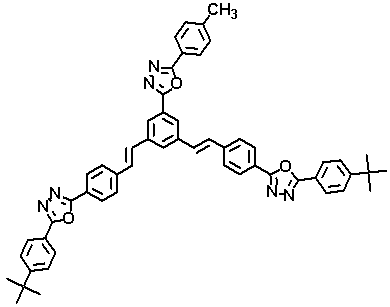 OXA3d
OXA3d 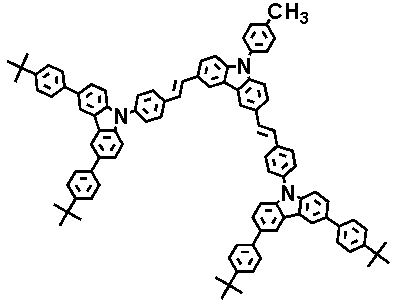 Cz3d
Cz3d  TPA-Cz3d
TPA-Cz3d
UNIMOLECULAR RECTIFIERS
Robert M. Metzger
Laboratory of Molecular Electronics, Department of Chemistry
University of Alabama, Tuscaloosa, AL 35487-0336, USA
tel=1-205-348-5952, fax=1-205-348-9104, e-mail=rmetzger@bama.ua.edu
In 1997 we showed that hexadecylquinolinium tricyanoquinodimethanide is a unimolecular rectifier, both by scanning tunneling microscopy and also by using a Langmuir-Blodgett monolayer of this molecule, sandwiched between aluminum electrodes [1]. The current is due an allowed electronic transition between the highly polar zwitterionic ground state and an excited state with much less polarity [2]. Very recently we observed the same rectification between gold electrodes: this required a deposition of "cold gold" atoms atop the organic monolayer [3]. The current is as high as 100,000 electrons per molecule per second, five orders of magnitude higher than for the Al electrodes (mostly covered by oxide) [3]. The rectification ratio can be as high as 27, but decreases upon repeated scans [3]. Two new rectifiers have been found, 2,6-di[dibutylamino-phenylvinyl]-1-butylpyridinium iodide, which seems to be interionic back-charge transfer rectifier [4], and dimethyanilinoazafullerene [5], in which Au stalagmites seem to form that dominate the current-voltage behavior.
[1] R. M. Metzger, B. Chen, U. Höpfner, M. V. Lakshmikantham, D. Vuillaume, T. Kawai, X. Wu, H. Tachibana, T. V. Hughes, H. Sakurai, J. W. Baldwin, C. Hosch, M. P. Cava, L. Brehmer, and G. J. Ashwell, ”Unimolecular Electrical Rectification in Hexadecylquinolinium Tricyanoquinodimethanide”, J. Am. Chem. Soc. 119(43): 10455-10466 (1997).
[2] R. M. Metzger, "Electrical Rectification by a Molecule: The Advent of Unimolecular Electronic Devices", Acc. Chem. Res. 32(11): 950-957 (1999).
[3] T. Xu, I. R. Peterson, M. V. Lakshmikantham, and R. M. Metzger, "Rectification by a Monolayer of Hexadecylquinolinium Tricyanoquinodimethanide between Gold Electrodes", Angew. Chem. Intl. Ed. 40(9): 1749-1752 (2001).
[4] J. W. Baldwin, R. R. Amaresh, I. R. Peterson, W. J. Shumate, M. P. Cava, M. A. Amiri, R. Hamilton, G. J. Ashwell, and R. M. Metzger, submitted to J. Phys. Chem. B.
[5] R. M. Metzger, J. W. Baldwin, W. J. Shumate, I. R. Peterson, P. Mani, G. J. Mankey, T. Morris, G. Szulczewski, S. Bosi, M. Prato, A. Comito, and Y. Rubin, subm. to J. Am. Chem. Soc.
Biographical sketch
Robert Melville Metzger was born in Yokohama, Japan of Hungarian parents in 1940, moved to Paris, France in 1946, to Merano, Italy in 1948, then to Los Angeles, CA in 1959. After degrees in chemistry from UCLA (1962 - research with W. F. Libby) and Caltech (1968 -with H. M. McConnell) and post-docs at Stanford (with P. G. Simpson and M. Boudart), Metzger taught Italian at Stanford (70-71) and chemistry at the University of Mississippi (71-86) and the University of Alabama (86-present), where he is Professor of Chemistry and Tricampus Director of the Materials Science Program. Metzger has published 166 papers, edited 3 books, got 1 patent, graduated 9 Ph.D's and 1 M.S,. and gave talks, or spent sabbatical or other leaves in 22 countries. In 1984 he became the first Coulter Professor of Chemistry at the University of Mississippi. In 1998 he received the Blackmon-Moody award for exceptional research at the University of Alabama.